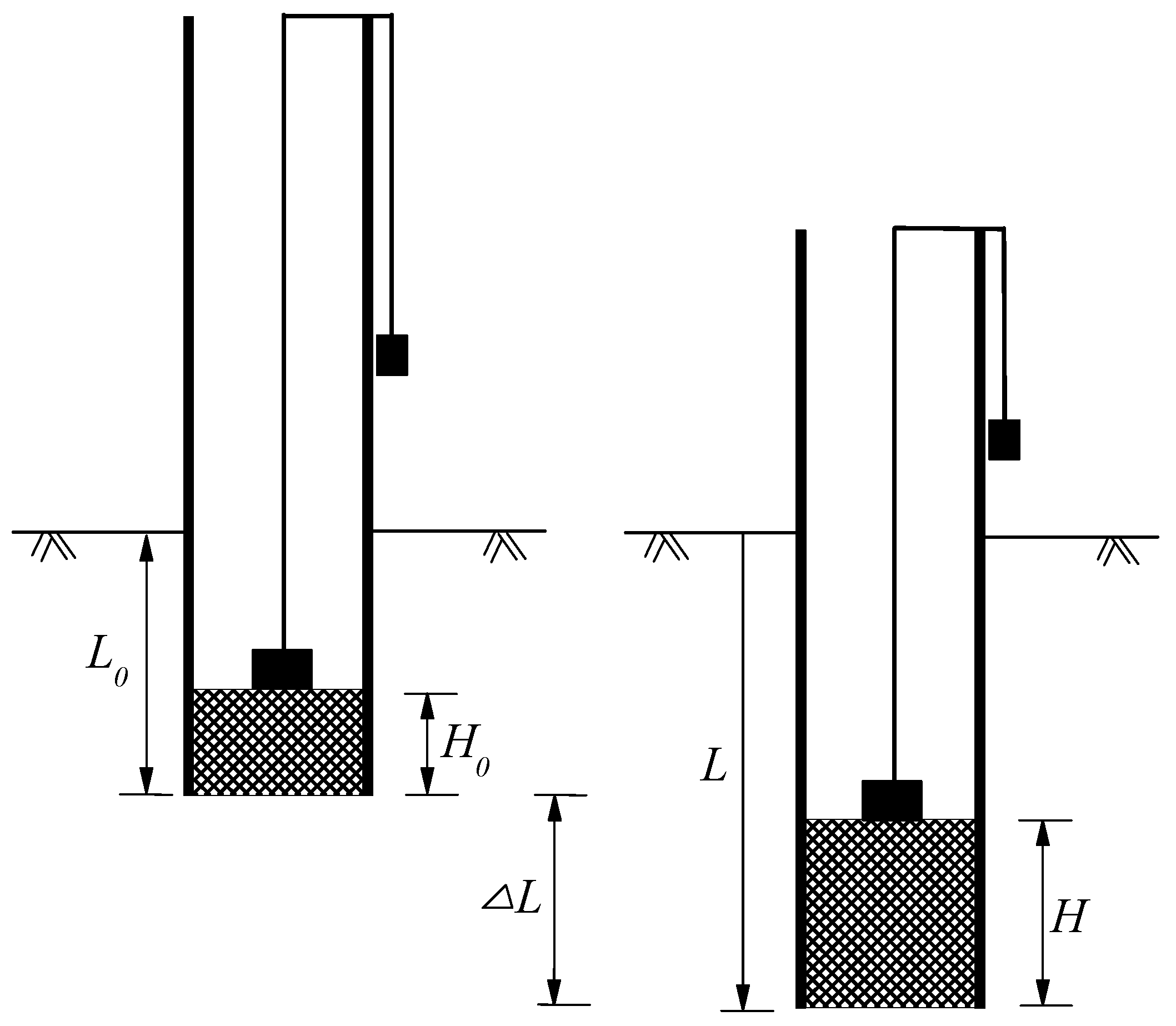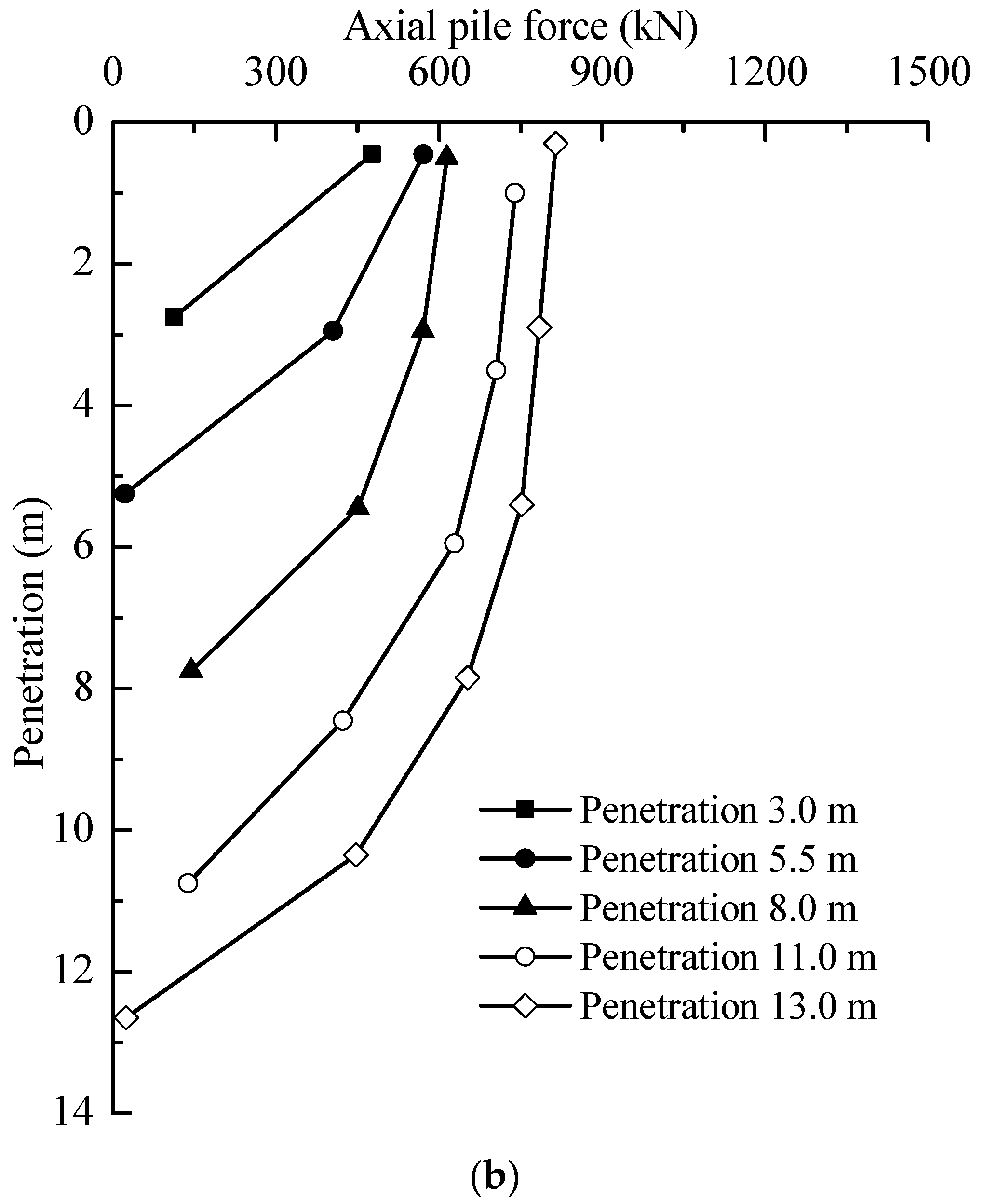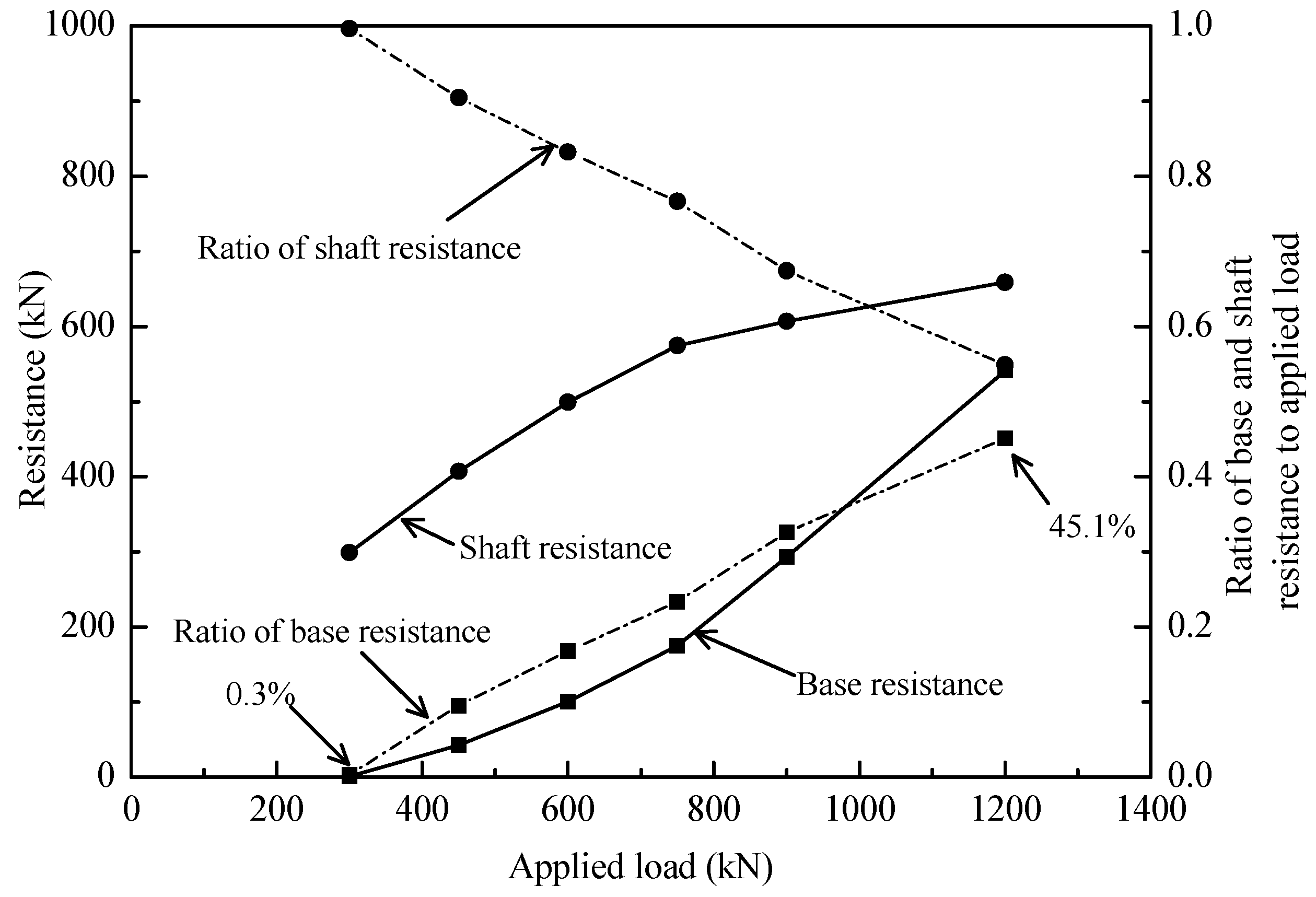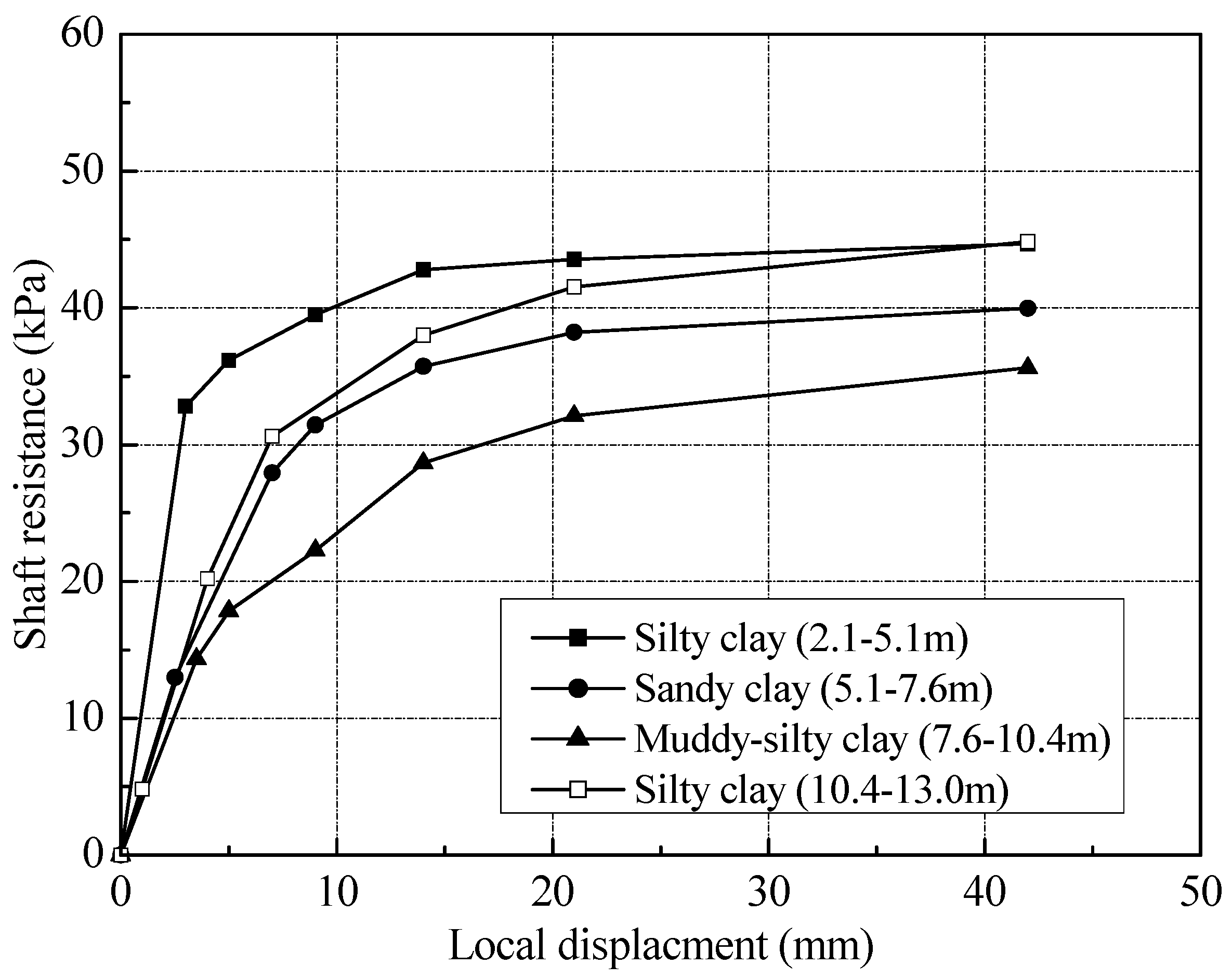Field Performance of Open-Ended Prestressed High-Strength Concrete Pipe Piles Jacked into Clay
Abstract
:1. Introduction
2. Site Conditions and Test Program
2.1. Site Description
2.2. Test Piles Details and Instrumentation
2.3. Test Program
3. Test Resultis and Discussion
3.1. End and Shaft Resistance during Jacking
3.2. Soil Plug Behavior
3.3. Residual Forces after Installation
3.4. Pile Behavior during Static Loading Test
4. Conclusions
- (1)
- The FBG sensoring technology was proved be feasible to measure the axial forces of jacked open-ended PHC pipe piles in clay. It is revealed that the axial forces along PHC pipe piles can be obtained through FBG sensor multiplexing technology.
- (2)
- The behaviour of open-ended PHC pipe piles is more complicated once the effect of soil plugging is considered. The open-ended PHC pipe piles were jacked into clay in a partially plugged mode while the behaved as fully plugged piles in loading tests. This implies that the soil plugging was very different under installation and static loading conditions.
- (3)
- The residual forces in open-ended PHC pipe piles after installation were large and always were compressive at pile toe. The ratios of residual end forces to end resistances after installation were 25.2 and 23.8%, respectively. The residual forces also significantly affect the interpretation of the load distribution in static loading test. The end resistances of the test piles will be underestimated by 4.2% if the residual forces are not considered. However, the residual forces do not affect the total bearing capacity as the sum of residual shaft and end resistances must equal zero.
- (4)
- Loading test results indicated that the shaft resistance has a good correlation with pile-soil relative displacement. The threshold of slip displacement for fully mobilizing the shaft resistance was found to be 15, 13 and 20 mm for silty clay, sandy clay and muddy-silty clay layers, respectively.
Author Contributions
Funding
Acknowledgments
Conflicts of Interest
References
- Lehane, B.M.; Chow, F.C.; McCabe, B.A.; Jardine, R.J. Relationships between shaft capacity of driven piles and CPT end resistance. Proc. Inst. Civ. Eng.-Geotech. Eng. 2000, 143, 93–102. [Google Scholar] [CrossRef]
- Zhang, L.M.; Ng, C.W.W.; Chan, F.; Pang, H.W. Termination criteria for jacked pile construction and load transfer in weathered soils. J. Geotech. Geoenviron. Eng. 2006, 132, 819–829. [Google Scholar] [CrossRef]
- Yang, J.; Tham, L.G.; Lee, P.K.K.; Chan, S.T.; Yu, F. Behaviour of jacked and driven piles in sandy soil. Geotechnique 2006, 56, 245–259. [Google Scholar] [CrossRef] [Green Version]
- Yang, J.; Tham, L.G.; Lee, P.K.K.; Yu, F. Observed performance of long steel H-piles jacked into sandy soils. J. Geotech. Geoenviron. Eng. 2006, 132, 24–35. [Google Scholar] [CrossRef]
- Yang, J.; Mu, F. Use of state-dependent strength in estimating end bearing capacity of piles in sand. J. Geotech. Geoenviron. Eng. 2008, 134, 1010–1014. [Google Scholar] [CrossRef]
- Yang, J.; Mu, F. Relating the maximum radial stress on pile shaft to pile base. Geotechnique 2011, 61, 1087–1092. [Google Scholar] [CrossRef]
- Igoe, D.J.P.; Gavin, K.G.; O’Kelly, B.C. Shaft capacity of open-ended piles in sand. J. Geotech. Geoenviron. Eng. 2011, 137, 903–913. [Google Scholar] [CrossRef]
- Randolph, M.F. Science and empiricism in pile foundation design. Geotechnique 2003, 53, 847–875. [Google Scholar] [CrossRef]
- Brucy, F.; Meunier, J.; Nauroy, J.F. Behavior of pile plugs in sandy soils during and after driving. In Proceedings of the 23rd Annual Offshore Technology Conference, OTC 6514, Houston, TX, USA, 6–9 May 1991; Volume 1, pp. 145–154. [Google Scholar]
- Smith, I.M.; To, P.; Wilson, S.M. Plugging of pipe piles. In Proceedings of the 3rd International Conference on Numerical Method in Offshore Piling, Nantes, France, 21–22 May 1986; pp. 53–73. [Google Scholar]
- Paik, K.H.; Salgado, R. Determination of the bearing capacity of open-ended piles in sand. J. Geotech. Geoenviron. Eng. 2003, 129, 46–57. [Google Scholar] [CrossRef]
- Kou, H.L.; Guo, W.; Zhang, M. Pullout performance of GFRP anti-floating anchor in weathered soil. Tunn. Undergr. Space Technol. 2015, 21, 437–442. [Google Scholar] [CrossRef]
- Kou, H.L.; Chu, J.; Guo, W.; Zhang, M.Y. Field study of residual forces developed in pre-stressed high-strength concrete (PHC) pipe piles. Can. Geotech. J. 2015, 53, 696–707. [Google Scholar] [CrossRef]
- Kou, H.L.; Guo, W.; Zhang, M.Y. Field study of set-up effect in open-ended PHC pipe piles. Mar. Georesour. Geotechnol. 2017, 35, 208–215. [Google Scholar] [CrossRef]
- Yu, F.; Yang, J. Base capacity of open-ended steel pipe piles in sand. J. Geotech. Geoenviron. Eng. 2011, 138, 1116–1128. [Google Scholar] [CrossRef]
- Lehane, B.M.; Schneider, J.A.; Xu, X. The UWA-05 method for prediction of axial capacity of driven piles in sand. In Frontiers in Offshore Geotechnics; CRC Press: Boca Raton, FL, USA, 2005; pp. 683–689. [Google Scholar]
- Lehane, B.M.; Schneider, J.A.; Xu, X. Development of the UWA-05 design method for open and closed ended driven piles in siliceous sand. In Contemporary Issues in Deep Foundations, ASCE 158; American Society of Civil Engineers: Reston, VI, USA, 2007; pp. 1–10. [Google Scholar]
- Moormann, C.; Labenski, J.; Aschrafi, J. Simulation of soil plug effects in open steel pipe piles considering the complex soil-structure-interaction during installation. In Proceedings of the 40th Annual Conference on Deep Foundations, Oakland, CA, USA, 12–15 October 2015; pp. 533–546. [Google Scholar]
- Miller, G.A.; Lutenegger, A.J. Influence of pile plugging on skin friction in overconsolidated clay. J. Geotech. Geoenviron. Eng. 1997, 123, 525–533. [Google Scholar] [CrossRef]
- Stevens, R.F. The effect of a soil plug on pile drivability in clay. In Proceedings of the 3rd International Conference on the Application of Stress Wave Theory to Piles, Ottawa, ON, Canada, 25–27 May 1988; pp. 861–868. [Google Scholar]
- Paikowsky, S.G.; Whitman, R.V.; Baligh, M.M. A new look at the phenomenon of offshore pile plugging. Mar. Georesour. Geotechnol. 1989, 8, 213–230. [Google Scholar] [CrossRef]
- Liu, J.W.; Zhang, Z.M.; Yu, F.; Xie, Z.Z. Case history of installing instrumented jacked open-ended piles. J. Geotech. Geoenviron. Eng. 2011, 138, 810–820. [Google Scholar] [CrossRef]
- Igoe, D.; Doherty, P.; Gavin, K. The development and testing of an instrumented open-ended model pile. Geotech. Test. J. 2010, 33, 72–82. [Google Scholar]
- Schmidt-Hattenberger, C.; Borm, G.; Amberg, F. Bragg grating seismic monitoring system. Proc. SPIE 1999, 3860, 417–424. [Google Scholar]
- Schmidt-Hattenberger, C.; Straub, T.; Naumann, M.; Borm, G.; Lauerer, R.; Beck, C.; Schwarz, W. Strain measurements by fiber Bragg grating sensors for in-situ pile loading tests. In Smart Structures and Materials 2003: Smart Sensor Technology and Measurement Systems; The International Society for Optical Engineering: Bellingham, WA, USA, 2003; Volume 5050, pp. 289–294. [Google Scholar]
- Klar, A.; Bennett, P.J.; Soga, K.; Mair, R.J.; Tester, P.; Fernie, R.; St John, H.D.; Torp-Peterson, G. Distributed strain measurement for pile foundations. Proc. Inst. Civ. Eng. Geotech. Eng. 2006, 159, 135–144. [Google Scholar] [CrossRef]
- Doherty, P.; Igoe, D.; Murphy, G.; Gavin, K.; Preston, J.; McAvoy, C.; Byrne, B.W.; Mcadam, R.; Burd, H.J.; Houlsby, G.T.; et al. Field validation of fibre Bragg grating sensors for measuring strain on driven steel piles. Geotech. Lett. 2015, 5, 74–79. [Google Scholar] [CrossRef] [Green Version]
- Schmidt-Hattenberger, C.; Naumann, M.; Borm, G. Dynamic strain detection using a fiber Bragg grating sensor array for geotechnical applications. In Proceedings of the European Workshop on Smart Structures in Engineering and Technology, Presquile de Giens, France, 21–23 May 2002; pp. 227–232. [Google Scholar]
- Schmertmann, J.H. Guidelines for Cone Penetration Test Performance and Design; Report No. FHWA-TS-78-209; US Department of Transportation, Federal Highway Administration, Offices of Research and Development: Washington, DC, USA, 1978.
- Paikowsky, S.G.; Whitman, R.V. The effect of plugging on pile performance and design. Can. Geotech. J. 1990, 27, 429–440. [Google Scholar] [CrossRef]
- Choi, Y.; O’Nell, M.W. Soil plugging and relaxation in pipe pile during earthquake motion. J. Geotech. Geoenviron. Eng. 1997, 123, 975–982. [Google Scholar] [CrossRef]
- Paik, K.; Salgado, R.; Lee, J.; Kim, B. Behaviour of open-and closed-ended piles driven into sands. J. Geotech. Geoenviron. Eng. 2003, 129, 296–306. [Google Scholar] [CrossRef]
- Hong, C.Y.; Zhang, Y.F.; Zhang, M.X.; Leung, L.M.G.; Liu, L.Q. Application of FBG sensors for geotechnical health monitoring, a review of sensor design, implementation methods and packaging techniques. Sens. Actuators A Phys. 2016, 244, 184–197. [Google Scholar] [CrossRef]
- MCC (Ministry of Construction of the People’s Republic of China). JGJ106-2014: Technical Code for Building Pile Foundations; China Building Industry Press: Beijing, China, 2014.
- Lehane, B.M.; Randolph, M.F. Evaluation of a minimum base resistance for driven pipe piles in siliceous sand. J. Geotech. Geoenviron. Eng. 2002, 128, 198–205. [Google Scholar] [CrossRef]
- Gavin, K.; Lehane, B.M. Base load-displacement response of piles in sand. Can. Geotech. J. 2007, 44, 1053–1063. [Google Scholar] [CrossRef]
- Fellenius, B.H.; Altaee, A.A. Critical depth: How it came into being and why it does not exist. Proc. ICE-Geotech. Eng. 1995, 113, 107–111. [Google Scholar] [CrossRef]
- Cooke, R.W. Influence of residual installation forces on the stress transfer and settlement under working loads of jacked and bores piles in cohesive soils. In Behavior of Deep Foundations; Special Technical Publication STP; ASTM: West Conshohocken, PA, USA, 1979; pp. 231–249. [Google Scholar]
- Poulos, H.B. Analysis of residual stress effects in piles. J. Geotech. Eng. ASCE 1987, 113, 216–229. [Google Scholar] [CrossRef]
- Darrag, A.A. Capacity of Driven Piles in Cohesionless Soils Including Residual Stress. Ph.D. Thesis, Purdue University, West Lafayette, IN, USA, 1987. [Google Scholar]
- Rieke, R.D.; Crowser, J.C. Interpretation of a pile load test considering residual stresses. J. Geotech. Geoenviron. Eng. 1987, 113, 320–334. [Google Scholar] [CrossRef]
- Kraft, L.M. Performance of axially loaded pipe piles in sand. J. Geotech. Eng. ASCE 1991, 117, 272–296. [Google Scholar] [CrossRef]




















| Soils Type | Depth (m) | W (%) | γ (kN/m3) | e0 (%) | Gs | LL (%) | PL (%) | α1-2 (MPa−1) | c (kPa) | φ (o) |
|---|---|---|---|---|---|---|---|---|---|---|
| Silty clay | 2.1~5.1 | 25.7 | 19.36 | 0.73 | 2.72 | 30.1 | 17.9 | 0.15 | 14.0 | 21.5 |
| Sandy clay | 5.1~7.6 | 31.2 | 18.52 | 0.87 | 2.69 | 33.3 | 26.4 | 0.18 | 7.1 | 29.4 |
| Muddy-silty clay | 7.6~10.4 | 44.8 | 17.07 | 1.28 | 2.74 | 37.0 | 19.7 | 0.87 | 15.8 | 8.0 |
| Silty clay | 10.4~13.0 | 23.4 | 19.77 | 0.67 | 2.72 | 28.6 | 15.8 | 0.22 | 28.5 | 22.8 |
| Pile number | Size (mm) | Embedded Length (m) | Elastic Modulus (GPa) | Axial Compressive Strength (MPa) |
|---|---|---|---|---|
| T1 | 400 (75) | 13.0 | 36.0 | 35.9 |
| T2 | 400 (75) | 13.0 | 36.0 | 35.9 |
© 2018 by the authors. Licensee MDPI, Basel, Switzerland. This article is an open access article distributed under the terms and conditions of the Creative Commons Attribution (CC BY) license (http://creativecommons.org/licenses/by/4.0/).
Share and Cite
Kou, H.-L.; Diao, W.-Z.; Liu, T.; Yang, D.-L.; Horpibulsuk, S. Field Performance of Open-Ended Prestressed High-Strength Concrete Pipe Piles Jacked into Clay. Sensors 2018, 18, 4216. https://doi.org/10.3390/s18124216
Kou H-L, Diao W-Z, Liu T, Yang D-L, Horpibulsuk S. Field Performance of Open-Ended Prestressed High-Strength Concrete Pipe Piles Jacked into Clay. Sensors. 2018; 18(12):4216. https://doi.org/10.3390/s18124216
Chicago/Turabian StyleKou, Hai-Lei, Wen-Zhou Diao, Tao Liu, Dan-Liang Yang, and Suksun Horpibulsuk. 2018. "Field Performance of Open-Ended Prestressed High-Strength Concrete Pipe Piles Jacked into Clay" Sensors 18, no. 12: 4216. https://doi.org/10.3390/s18124216




